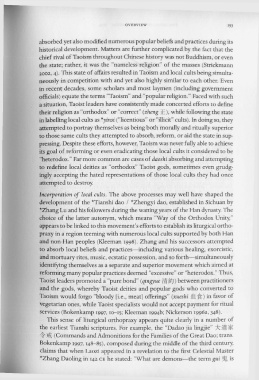Page 193 - The Encyclopedia of Taoism v1_A-L
P. 193
OV E RVI EW 153
absorbed yet also modified numerous popular beliefs and practices during its
historical development. Matters are further complicated by the fact that the
chief rival of Taoism throughout Chinese history was not Buddhism, or even
the state; rather, it was the "nameless religion" of the masses (Strickmann
2002, 4). This state of affairs resulted in Taoism and local cults being simulta-
neously in competition with and yet also highly similar to each other. Even
in recent decades, some scholars and most laymen (including government
officials) equate the terms "Taoism" and "popular religion." Faced with such
a situation, Taoist leaders have consistently made concerted efforts to define
their religion as "orthodox" or "correct" (zheng lE), while follOWing the state
in labelling local cults as *yinsi ("licentious" or "illicit" cults). In doing so, they
attempted to portray themselves as being both morally and ritually superior
to those same cults they attempted to absorb, reform, or aid the state in sup-
pressing. Despite these efforts, however, Taoism was never fully able to achieve
its goal of reforming or even eradicating those local cults it considered to be
"heterodox." Far more common are cases of daoshi absorbing and attempting
to redefine local deities as "orthodox" Taoist gods, sometimes even grudg-
ingly accepting the hated representations of those local cults they had once
attempted to destroy.
Incorporation of local cults. The above processes may well have shaped the
development of the *Tianshi dao / *Zhengyi dao, established in Sichuan by
*Zhang Lu and his followers during the waning years of the Han dynasty. The
choice of the latter autonym, which means "Way of the Orthodox Unity,"
appears to be linked to this movement's efforts to establish its liturgical ortho-
praxy in a region teeming with numerous local cults supported by both Han
and non-Han peoples (Kleeman 1998). Zhang and his successors attempted
to absorb local beliefs and practices-including various healing, exorcistic,
and mortuary rites, music, ecstatic possession, and so forth-simultaneously
identifying themselves as a separate and superior movement which aimed at
reforming many popular practices deemed " excessive" or "heterodox." Thus,
Taoist leaders promoted a "pure bond" (qingyue 1W~) between practitioners
and the gods, whereby Taoist deities and popular gods who converted to
Taoism would forgo 'bloody [i.e., meat] offerings" (xueshi .rtn.1t) in favor of
vegetarian ones, while Taoist specialists would not accept payment for ritual
services (Bokenkamp 1997, 10-15; Kleeman 1994b; Nickerson 1996a, 348).
This sense of liturgical orthopraxy appears quite clearly in a number of
the earliest Tianshi scriptures. For example, the "Dadao jia lingjie" 1::. J!t *
A fiX: (Commands and Admonitions for the Families of the Great Dao; trans.
Bokenkamp 1997, 148- 85), composed during the middle of the third century,
claims that when Laozi appeared in a revelation to the first Celestial Master
*Zhang Daoling in 142 CE he stated: "What are demons- the term gui % is

